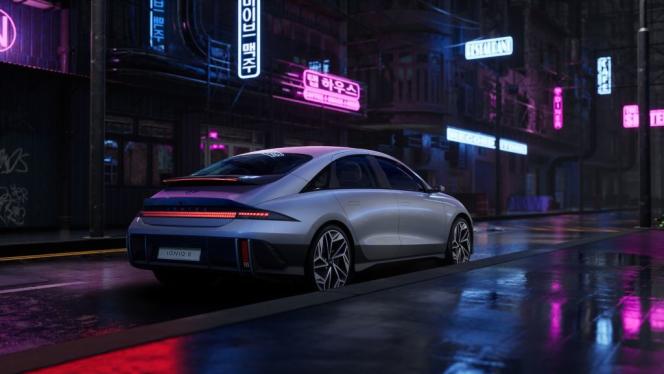To the South Korean manufacturers, in particular Hyundai, we must recognize the merit of bringing a touch of singularity in an automotive landscape that is far too standardized. The style of their cars generally escapes the grayness and predictability that too often affect the production of European brands. One would have thought that their audacity was mainly aimed at filling a lack of notoriety, but this is not the case. Now recognized, even partially trivialized, these firms continue to play the element of surprise, especially for their electric vehicles.
The long and slender Ioniq 6 from Hyundai has become, since its launch at the end of 2022, an object of curiosity. Because it renews the idea that one can have of a large sedan, but also because it explores a stylistic language at odds with that of the Ioniq 5, a vast cubic and monospacizing SUV, which appeared in 2022.
This approach, based on the belief that a model’s personality should trump sacrosanct brand identity, puts Hyundai in a special position. It imposes a permanent renewal of design and, therefore, the questioning of all choices, including those that work well.
Improved efficiency
The Ioniq 6, imposing and a bit enigmatic sedan of 4.85 meters, has a sober and fairly classic front end, but a rear part far from the usual standards. The bonnet is short, and the streamlined roofline drops very far back, forming a double spoiler.
Highlighted by a light strip also installed in the low position, the construction of this rear – which is reminiscent of the generation of four-door coupés that appeared in the early 2000s, embodied by the majestic Mercedes CLS – did not nothing very airy.
We can even find it a little crowded, but it ensures an optimized diffusion of the air flows. We like or not the atypical look of this sedan which can boast of a Cx (coefficient of penetration in the air) of 0.22 – a rather unusual score – but we inevitably notice it.
In addition to leading aerodynamics, the Ioniq 6 benefits from improved efficiency compared to the Ioniq 5, synonymous with very low consumption levels (14.3 kilowatt hours per 100 kilometers), despite a power, which, depending on the version, reached 229 or 325 horsepower. If you adopt a quiet driving style, you can do even better without forcing it.
As the battery (77.4 kilowatt hours) imposes, the car is theoretically cut for a range of just over 600 kilometers, which will have to be significantly reduced on the highway. Stops on high-power terminals will be shortened thanks to the 800-volt architecture, but since the AC charger is not capable of exceeding 11 kilowatts, less efficient terminals will impose longer downtimes.
You have 39.1% of this article left to read. The following is for subscribers only.
